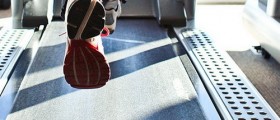* Under full throttle, a dragster engine consumes 1 gallons of nitromethane per second; a fully loaded 747 consumes jet fuel at the same rate with 25% less energy being produced.
* A stock Dodge Hemi V8 engine cannot produce enough power to drive the dragster supercharger.
* With 3000 CFM of air being rammed in by the supercharger on overdrive, the fuel mixture is compressed into a near-solid form before ignition. Cylinders run on the verge of hydraulic lock at full throttle.
* At the stoichiometric 1.7:1 air/fuel mixture for nitromethane the flame
front temperature measures 7050 degrees F.
* Nitromethane burns yellow. The spectacular white flame seen above the stacks at night is raw burning hydrogen, dissociated from atmospheric water vapour by the searing exhaust gases.
* Dual magnetos supply 44 amps to each spark plug. This is the output of
an arc welder in each cylinder.
* Spark plug electrodes are totally consumed during a pass. After way,
the engine is dieseling from compression plus the glow of exhaust valves at 1400 degrees F. The engine can only be shut down by cutting the fuel flow.
* If spark momentarily fails early in the run, unburned nitro builds up in the affected cylinders and then explodes with sufficient force to blow cylinder heads off the block in pieces or split the block in half.
* In order to exceed 300 mph in 4.5 seconds dragsters must accelerate at
an average of over 4G's. In order to reach 200 mph well before half-track, the launch acceleration approaches 8G's.
* Dragsters reach over 300 miles per hour before you have completed
reading this sentence.
* Top Fuel Engines turn approximately 540 revolutions from light to light!
* Including the burnout the engine must only survive 900 revolutions
under load.
* The redline is actually quite high at 9500rpm.
* The Bottom Line; Assuming all the equipment is paid off, the crew worked for free, and for once NOTHING BLOWS UP, each run costs an estimated US$1,000.00 per second. The current Top Fuel dragster elapsed time record is 4.441 seconds for the quarter mile (10/05/03, Tony Schumacher). The top speed record is 333.00 mph (533 km/h) as measured over the last 66' of the run (09/28/03 Doug Kalitta).
Putting all of this into perspective:
You are driving the average $140,000 Lingenfelter "twin-turbo" powered Corvette Z06. Over a mile up the road, a Top Fuel dragster is staged and
ready to launch down a quarter mile strip as you pass. You have the advantage of a flying start. You run the 'Vette hard up through the gears and blast across the starting line and past the dragster at an honest 200 mph. The 'tree' goes green for both of you at that moment. The dragster launches and starts after you. You keep your foot down hard, but you hear an incredibly brutal whine that sears your eardrums and within 3 seconds the dragster catches and passes you. He beats you to the finish line, a quarter mile away from where you just passed him. Think about it, from a standing start, the dragster had spotted you 200 mph and not only caught, but nearly blasted you off the road when he passed you within a mere 1320 foot long race course.
That, folks, is acceleration.
Loading...
I wish they would update that, it's been around for about 10 years now. It used to be on NHRA's website, don't know if still is.
Loading...
Loading...
Loading...
Loading...
Now lets talk weight to HP ratio's. My son is an avid VW Dragster engine builder...using of course, the old 4 banger VW beetle engines. The car he is building for himself with the Xbrother-in-law, has a special drag trans-axle, a fiberglass body, and *drum roll* a 340 HP engine...not counting the N02... Now remember that a stock old style VW Beetle engine has about 40-60 HP. It is truly an engineering feat as to what those two can get out of a 1960's vintage Bug engine
He has also been warned not to take it into Radnor Township....unless he wants to donate it to the Po Po as an unmarked Interceptor :P
Loading...
That fighter weighs a LOT more than a bare J47 with wheels and a parachute. We ran a blown 392 but had no idea what the HP was. We certainly weren't about to put it on a dyno just to waste at least a run or maybe 2 on the engine. A fresh build lasted us for a season and we couldn't afford to waste any runs on it.
They have done a lot getting more power out of the engines they use today. My last car had a Chrysler 440 in it which began life with close to 400 hp but by the time mine was built in 1978 they had it down to somewhere around 200 (nobody knows for sure) to satisfy the government. The original version got a reliable 18 mpg on a trip and 12 to 14 around town. By the time the EPA was through with mine it got 15 on a trip and 6 to 10 around town. I still can't understand how using twice as much gas to drive around town correlates to less pollution but I never worked for the EPA so how would I know?
The CVPI I have now gets 22 on a trip and close to 18 around town with only 281 cubes and 250 hp. Of course it weighs 1000 pounds less than the Chrysler did. It has a funny trick that comes standard on them apparently. My DOT cop friend asked me about it as they had them and never found a fix. Most of the time it drives like a normal car but once in a while it takes off from a stop like a chicken that just saw the colonel behind it.
Loading...
Loading...
Joe, can you wrap your mind around what it would be like to have an interceptor that looks like a 1964 VW, that can outrun any of those hot little rice burners...or for that matter...just about anything on 2 or 4 wheels?
It is, by the way...gona be street legal
Bud is gona have to take you for a ride....at the race track of course
Now if it were black and white...with a whelen edge light bar, and code 3 siren........
